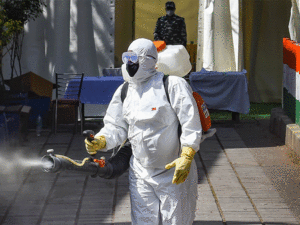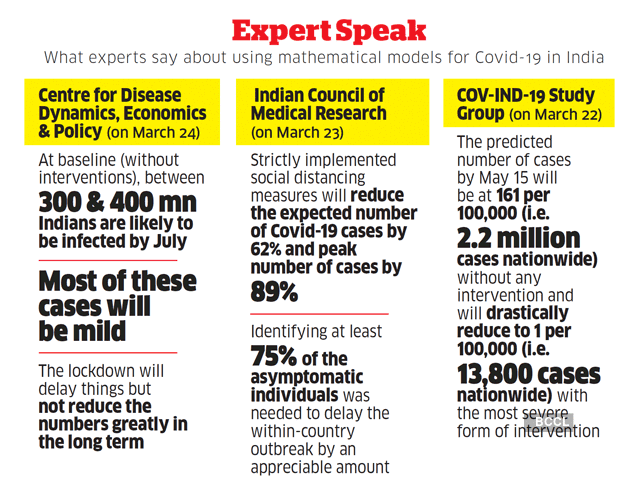
The use of modelling to map an infectious disease goes back a couple of centuries.

COVID-19 CASES
WorldIndiaConfirmed7,529Deaths242Confirmed1,691,719Deaths102,525Will the novel coronavirus infect millions in India? How many are likely to die? Does social distancing actually help save lives and how long should it last? These are some of the questions people are grappling with amid the Covid-19 pandemic.
While it is impossible to get precise answers to these questions, epidemiologists and policymakers turn to mathematical models to navigate the pandemic and help take critical decisions. These models, which extrapolate from existing data to predict the progression of an infectious disease outbreak, have come to play an integral role in infectious disease epidemiology.
Such modelling helps one understand the trajectory of a disease over time, how fast it is increasing and what might determine that increase, says Gautam Menon, professor of physics and biology at Ashoka University.
“They also help you understand what an intervention like physical distancing or a lockdown might do,” says Menon, whose areas of expertise includes modelling infectious disease and its implication for public policy.
These models also help experts understand if a health system is geared up in terms of medical personnel and equipment to tackle the infection, says Ramanan Laxminarayan, director of the Center for Disease Dynamics, Economics and Policy. For instance, in its model released on March 24, CDDEP said India would need 1 million ventilators when the infection peaked, during which 100 million individuals could be affected.
The use of modelling to map an infectious disease goes back a couple of centuries.
One of the first attempts was made by 18th century mathematician Daniel Bernoulli, who tried to map the spread of smallpox.
A century later, John Snow, a doctor in England, used statistics and mapping to determine the mode of spread of cholera.

Modelling has become considerably more sophisticated since then. “Work on epidemiology is now conducted by data scientists more than doctors,” says Laxminarayan.
Giridhar R Babu, who heads lifecourse epidemiology at Public Health Foundation of India, says models become more realistic when you combine the efforts of the best mathematical modellers with those of people who have worked on the ground. “If your assumptions are not based on pragmatic realities, you might end up with results that are blown out of proportion,” he cautions.
The success of a model depends on the data it uses. One of the challenges epidemiologists are grappling with now in India is the lack of data to track Covid-19’s trajectory. “As the data we require lies primarily with the government, the only solution is for the government to be more forthcoming with it,” says Menon.
N Devadasan, cofounder of Institute of Public Health, says he is sceptical about modelling about Covid-19 in India because of the lack of reliable data. “At present, we are relying entirely on Italian and Chinese figures.”
The infection rate, says the public health veteran, has been taken from China and Italy to make a projection for India. The other obstacle, Devadasan says, is that people are not considering that most patients may not be transmitting. “We are assuming that all patients who are infected will transmit, which is not the case.”
Devadasan has taken a more conservative view of the progression of Covid-19 in India. In an article in Scroll earlier this month, he said that data available so far suggested that the novel coronavirus might not infect millions in India.
“I am hoping that with the lockdown, we have reduced the transmission rate at this point, at least to some extent. This doesn’t mean that we will not get new infections. It is just that it will happen at a lower rate, not like what is happening in the US now or in Italy earlier,” he tells ET Magazine.
On the CDDEP model’s projection that India might see millions of cases, Laxminarayan says most people will have to experience some form of the disease — at best a mild one or even one without symptoms. “But our focus should be on the peak severe-infections that will tax our health system. If we can ‘push down’ and ‘push out’ that peak by keeping distance, then we would have helped all other Indians.”
For the uninitiated, the differing projections of varying models can seem puzzling. All models make assumptions but how realistic a model is depends on the assumptions being used, says PHFI’s Babu. “Your model is only as good as your assumptions. Depending on what you are comparing with, your scenarios change.”
The layperson trying to make sense of the many models might do well to be sceptical of hype and beware of apocalyptic scenarios, says Menon.
In the current situation, Laxminarayan says the baseline scenario or benchmark has been similar across models, at a rough infection rate of 10-30%. The bigger challenge, he says, is the outcome of an event such as a lockdown because of the lack of data about how it has reduced transmission. “In reality, the biggest unknown in disease models is human behaviour and how people react to protect themselves.”
After all, Babu says, a basic lesson all epidemiologists are taught is, “All models are wrong but some are useful.”
Source: indiatimes.com

